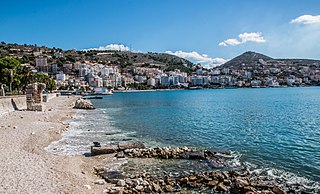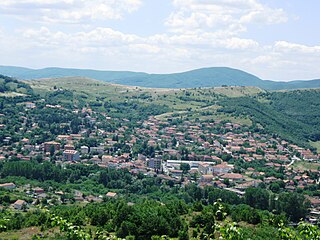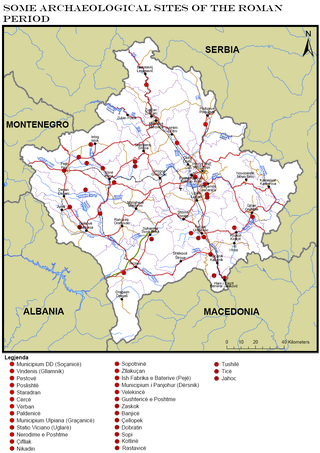
Gjakova or Đakovica is the seventh largest city of Kosovo and seat of Gjakova Municipality and Gjakova District. The city has 40,827 inhabitants, while the municipality has 94,556 inhabitants.

Kosovo Polje or Fushë Kosova, is a town and municipality located in the District of Pristina in Kosovo. According to the 2011 census, the town of Kosovo Polje has 12,919 inhabitants, while the municipality has 33,977 inhabitants.

Mitrovica, also referred as Kosovska Mitrovica, is a city in northern Kosovo and administrative center of the District of Mitrovica. In 2013, the city was split into two municipalities, South Mitrovica and North Mitrovica. Settled 10 km from Ujmani/Gazivoda Lake, on the confluence of the rivers Ibar, Sitnica, Lushta, and Trepça, the city is surrounded by the mountains of Kopaonik, Rogozna, Mokna, and Çyçavica. According to the 2011 Census, the two municipalities had 97,686 inhabitants of which 85,360 reside in south and 12,326 in north.

Prizren is the second most populous city and municipality of Kosovo and seat of the eponymous municipality and district. It is located on the banks of the Prizren River between the foothills of the Sharr Mountains in southern Kosovo. Prizren experiences an oceanic climate under the influence of the surrounding mountains.

Istog or Burim is a town and municipality located in the District of Peja of western Kosovo. According to the 2011 census, the city of Istog has 5,115 inhabitants, while the municipality has 39,289 inhabitants. Based on the population estimates from the Kosovo Agency of Statistics in 2016, the municipality has 39,982 inhabitants.

Sarandë is a city in the Republic of Albania and seat of Sarandë Municipality. Geographically, the city is located on an open sea gulf of the Ionian Sea within the Mediterranean Sea. Stretching along the Albanian Ionian Sea Coast, Sarandë has a Mediterranean climate with over 300 sunny days a year.

The District of Peja is one of the seven districts of the Kosovo. It has its seat in the city of Peja.

Novo Brdo or Novobërda and Artanë, is a town and municipality located in the Prishtina district of Kosovo. According to the 2011 census, it has a population of 6,729 inhabitants. The center of the municipality is the village of Bostane. The region is especially known for its role in mining during medieval times, in particular after the construction of the Novo Brdo Fortress by Stefan Milutin to house Saxon miners who were brought in the region.

Zvečan or Zveçan is a town and municipality located in the Mitrovica District in Kosovo. As of 2015, it has a population of 16,650 inhabitants. It covers an area of 122 km2 (47 sq mi), and consists of a town and 35 villages.

Medveđa is a town and municipality located in the Jablanica District of southern Serbia. As of the 2022 census, the municipality has a population of 6,360, while the town has a population of 2,993.

Malisheva is a town and municipality in Kosovo. According to the Kosovo Agency of Statistics (KAS) estimate from the 2011 census, there were 54,613 people residing in Malisheva Municipality, with Kosovo Albanians constituting the majority of the population.

Skenderaj or Srbica is a town and municipality located in the Mitrovica District of Kosovo. According to the 2021 census, the municipality of Skënderaj has 52,586 inhabitants.

Dragash or Sharr is a town and municipality located in the Prizren District of Kosovo. According to the 2011 census, the town of Dragash has 1,098 inhabitants, while the municipality has 34,827 inhabitants. The Albanian name Sharri is a reference to the Šar Mountains. The Serbian name Dragaš comes from medieval Serbian lord Constantine Dragaš.

North Mitrovica or North Kosovska Mitrovica, is a town and municipality located in Mitrovica District in Kosovo. As of 2015, it has a population of 29,460 inhabitants. It covers an area of 11 km2 (4 sq mi).
Dresnik is a settlement in the Klina municipality of Kosovo.

Ferizaj or Uroševac, is a city and a municipality in Kosovo. It is the third largest city in Kosovo by population and also the seat of Ferizaj Municipality and the Ferizaj District.

Janjevo or Janjevë is a village or small town in the Lipjan municipality in eastern Kosovo.

The Roman heritage sites in Kosovo represent a multitude of monuments of material and spiritual culture, which reflect the Roman period in this region. Among them, a special place is occupied by those that represent the development of art, such as the plastic monuments that are more frequent, and at the same time occupy an important place, because with the presentation of figures in relief and with numerous inscriptions they speak to us enough for this period.

The District of Peja is one of the biggest districts located in the northern hemisphere of Kosovo. Istog and Klina are the two biggest cities after Peja belonging to this particular district. During the course of history, numerous religions dominated in the aforementioned district starting from Illyrian ‘polytheist religions’, to Catholicism to Islam. Despite the numerous ethnic frictions in the region, its diverse religious groups have practiced their faiths openly and have largely lived in harmony.

The Kosovo Agency of Statistics monitors various demographic features of the population of Kosovo, such as population density, ethnicity, education level, health of the populace, economic status, religious affiliations and other aspects of the population. Censuses, normally conducted at ten-year intervals, record the demographic characteristics of the population. According to the first census conducted after the 2008 declaration of independence in 2011, the permanent population of Kosovo had reached 1,810,366.

























